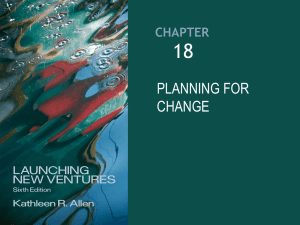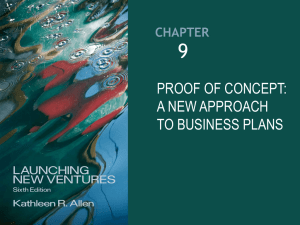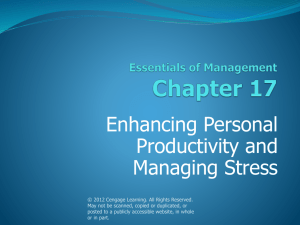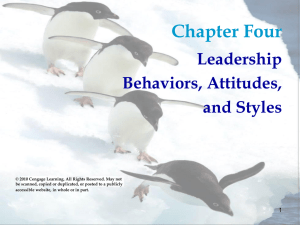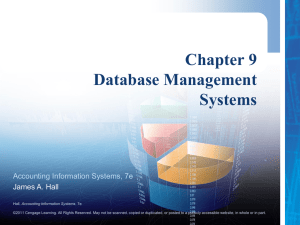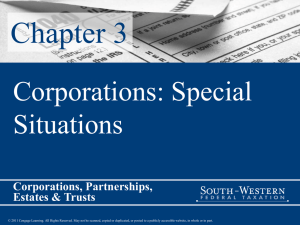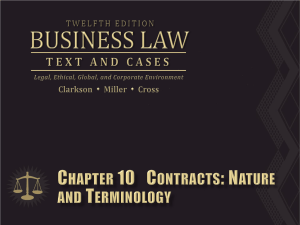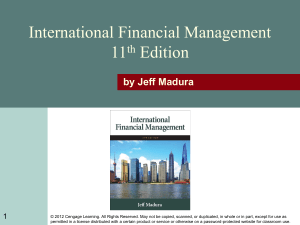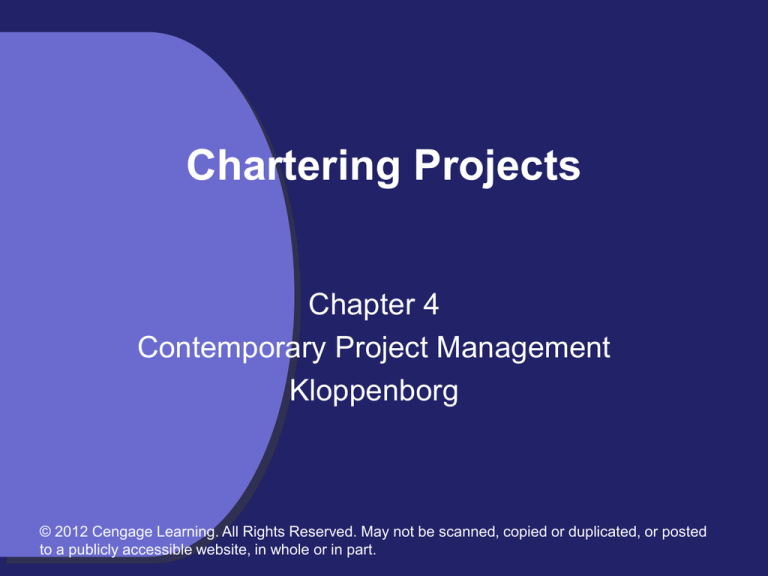
Chartering Projects
Chapter 4
Contemporary Project Management
Kloppenborg
© 2012 Cengage Learning. All Rights Reserved. May not be scanned, copied or duplicated, or posted
to a publicly accessible website, in whole or in part.
Chapter
Vignette
Ball Aerospace & Technologies Corp
• Systems Engineering Solutions provides a wide
range of air, space, and counterspace
engineering and professional analytic services
• Increase stakeholder by-in by addressing and
thinking about things up front
• By going through the chartering process,
stakeholders take ownership in the project.
• Project sponsors are typically U.S. government
customers
© 2012 Cengage Learning. All Rights Reserved. May not be scanned, copied or duplicated, or posted
to a publicly accessible website, in whole or in part.
Chapter
Vignette
Ball Aerospace & Technologies Corp
• The pre-chartering process: Initial statements
of work or objectives defining their goals for the
task and then select among several proposals
• The project charter:
– Overall project objectives
– Contrast between technical approach as written in the
company’s proposal for execution and sponsor
expectations
– Milestones, checkpoints, and potential payment plans
– Success criteria and schedule
– Identification of key stakeholders and risks
– Processes for executing, monitoring, controlling, and
overall management of the project
At the end of this chapter…
• Describe what a project charter is and why it is
critical to project success.
• List the various elements of a charter and tell
why each is used.
• Create each section of a charter for a small
sample project using given project information.
• Work with a team to create a complete charter
for a real project.
• Initialize a project in Microsoft Project and set up
a milestone schedule.
© 2012 Cengage Learning. All Rights Reserved. May not be scanned, copied or duplicated, or posted
to a publicly accessible website, in whole or in part.
What is a Project Charter?
• An informal contract between the project team
and the sponsor
• A contract
– is an agreement entered into freely by two or more
parties.
– cannot arbitrarily be changed
– offers something of value for each party
– is a living document that can evolve with changing
conditions
© 2012 Cengage Learning. All Rights Reserved. May not be scanned, copied or duplicated, or posted
to a publicly accessible website, in whole or in part.
What is a Project Charter?
• Signing a charter represents the transition from
the project initiating stage into the project
planning stage
© 2012 Cengage Learning. All Rights Reserved. May not be scanned, copied or duplicated, or posted
to a publicly accessible website, in whole or in part.
Why is a Project Charter used?
• The four major purposes for a charter are to:
1. authorize the project manager to proceed
2. help the project team and sponsor develop a
common understanding
3. help the project team and sponsor commit
4. quickly screen out obviously poor projects
© 2012 Cengage Learning. All Rights Reserved. May not be scanned, copied or duplicated, or posted
to a publicly accessible website, in whole or in part.
1. Authorize the project manager to
proceed
• The project charter authorizes the commitment
of resources to a project
• The project charter gives the project and the
project manager official status within the parent
organization.
Project charter “formally authorizes the project …
documents initial requirements that satisfy the stakeholders’
needs and expectations … and provides the project manager
the authority to apply resources to project activities.”
PMBOK® Guide
© 2012 Cengage Learning. All Rights Reserved. May not be scanned, copied or duplicated, or posted
to a publicly accessible website, in whole or in part.
2. Common understanding
• Benefits associated with the common
understanding include:
– Teamwork develops.
– Agreement, trust, communication, and commitment
between the sponsor, project manager, and project
team develop
– The project team does not worry if management will
accept a decision.
– The sponsor is less likely to unilaterally change the
original agreement.
© 2012 Cengage Learning. All Rights Reserved. May not be scanned, copied or duplicated, or posted
to a publicly accessible website, in whole or in part.
When is a
charter
needed?
Typical Elements in a Project
Charter
• The term “charter” may be substituted with
project request, project submission form, project
preplanning form
• Typical elements of a project charter include:
Title
Scope overview
Business case
Background
Milestone schedule
Risks, assumptions, constraints
Spending approvals/budget estimates
Communication plan requirements
Team operating principles
Lessons learned
Signatures and commitment
© 2012 Cengage Learning. All Rights Reserved. May not be scanned, copied or duplicated, or posted
to a publicly accessible website, in whole or in part.
Typical Elements in a Project Charter
Scope Overview
• A high-level description of what needs to be
accomplished and how it will be done
• The project in a nutshell
Product scope – “features and functions that characterize a
product, service or result.” PMBOK® Guide
Requirements – “condition or capability that must
be met…to satisfy…needs, wants, and expectations of the
sponsor, customer, and other stakeholders.” PMBOK® Guide
© 2012 Cengage Learning. All Rights Reserved. May not be scanned, copied or duplicated, or posted
to a publicly accessible website, in whole or in part.
Scope Overview
• Used to help prevent scope creep
• Considered to be the project boundaries
Scope creep – “adding features and functionality (project
scope) without addressing the effects of time, costs, resources,
or without customer approval.” PMBOK® Guide
© 2012 Cengage Learning. All Rights Reserved. May not be scanned, copied or duplicated, or posted
to a publicly accessible website, in whole or in part.
Business Case
•
•
•
•
The project purpose or justification statement
Answers the question “why?”
Used to justify the necessity of the project
Clearly tie the project to the organization’s
strategy
• May be just the rationale or include high-level
estimates of the costs and benefits of the project.
• Persuades decision makers to support the project
and inspire team members to work hard on it.
© 2012 Cengage Learning. All Rights Reserved. May not be scanned, copied or duplicated, or posted
to a publicly accessible website, in whole or in part.
Background
• Used to provide more detail to support the scope
statement and business case statements
• The background statement is optional
© 2012 Cengage Learning. All Rights Reserved. May not be scanned, copied or duplicated, or posted
to a publicly accessible website, in whole or in part.
Milestone Schedule with Acceptance
Criteria
• Divides the project into 3 to 8 intermediate points
whose completion can be verified
• Lists major milestones and deliverables
Milestone schedule – “a summary-level schedule that
identifies the major schedule milestones or significant points
or events in the project.” PMBOK® Guide
Deliverable – “any unique and verifiable product, result, or
capability to perform a service that must be produced to
complete a process, phase, or project. Often … subject to
approval by the project sponsor or customer.” PMBOK® Guide
© 2012 Cengage Learning. All Rights Reserved. May not be scanned, copied or duplicated, or posted
to a publicly accessible website, in whole or in part.
Milestone Schedule with Acceptance
Criteria
• A column for acceptance criteria helps
determine who will judge the quality of the
deliverable and by what criteria
• Acceptance criteria represent the project’s vital
signs
• Never turn in a deliverable without knowing how
it will be judged
Acceptance criteria – “those criteria, including performance
requirements and essential conditions, which must be met
before project deliverables are accepted.” PMBOK® Guide
© 2012 Cengage Learning. All Rights Reserved. May not be scanned, copied or duplicated, or posted
to a publicly accessible website, in whole or in part.
Risks, Assumptions, and Constraints
Risk – “an uncertain event or condition that, if it occurs, has a
positive or negative effect on a project’s objectives.” PMBOK®
Guide
Assumptions – “factors that, for planning purposes, are
considered to be true, real, or certain without proof or
demonstration.” PMBOK® Guide
Constraint – “an applicable restriction or limitation, either
internal or external to the project, that will affect the
performance of the project.” PMBOK® Guide
© 2012 Cengage Learning. All Rights Reserved. May not be scanned, copied or duplicated, or posted
to a publicly accessible website, in whole or in part.
Risks, Assumptions, and Constraints
• Reminders of what could prevent successful
completion of a project
• The more comprehensive, the more likely to
discover problems before they occur
• A false assumption becomes a risk
• A constraint that limits money, time, or resources
is a risk
© 2012 Cengage Learning. All Rights Reserved. May not be scanned, copied or duplicated, or posted
to a publicly accessible website, in whole or in part.
Risks
• Any risk that may inhibit successful project
completion needs to be identified and a plan
must be developed to overcome it.
• A risk that can create a positive effect on a
project can be considered an opportunity
• Must consider the risk of NOT undertaking the
project
• Contingency plans are developed for each major
identified risk
• An “owner” is assigned responsibility for each
contingency plan
© 2012 Cengage Learning. All Rights Reserved. May not be scanned, copied or duplicated, or posted
to a publicly accessible website, in whole or in part.
Spending Approvals or Budget
Estimates
• A preliminary budget should include the level of
confidence in the estimate
• Some internal projects do not develop formal
budgets
• Identify expenses the project manager can
authorize and expenses the sponsor needs to
control
© 2012 Cengage Learning. All Rights Reserved. May not be scanned, copied or duplicated, or posted
to a publicly accessible website, in whole or in part.
Team Operating Principles
• Established to enhance team functioning
• Goal is to increase team effectiveness
• Ensure that all parties are aware of what is
expected
• Useful team operating principles deal with
conducting meetings, making decisions,
accomplishing work, and treating each other
with respect.
© 2012 Cengage Learning. All Rights Reserved. May not be scanned, copied or duplicated, or posted
to a publicly accessible website, in whole or in part.
Lessons Learned
• Successes and failures of previous projects
become practical advice
• Avoid the risk of repeating mistakes from
previous projects
Lessons learned – “the learning gained from the process of
performing the project.” PMBOK® Guide
Lessons learned knowledge base – “a store of historical
information and lessons learned about both the outcomes of
previous project selection decisions and previous project
performance.” PMBOK® Guide
© 2012 Cengage Learning. All Rights Reserved. May not be scanned, copied or duplicated, or posted
to a publicly accessible website, in whole or in part.
Signatures and Commitment
•
•
•
•
Who is involved
Extent to which each person can make decisions
Expected time commitment for each person
The project sponsor, project manager, and core
team members show commitment by signing the
charter
© 2012 Cengage Learning. All Rights Reserved. May not be scanned, copied or duplicated, or posted
to a publicly accessible website, in whole or in part.
Constructing a Project Charter
• It is helpful if the sponsor creates the first draft
• The organization’s leadership team may
contribute information in addition to the business
case and scope overview
• One to four sentences should be written for the
scope overview and business case
© 2012 Cengage Learning. All Rights Reserved. May not be scanned, copied or duplicated, or posted
to a publicly accessible website, in whole or in part.
Scope Overview and Business Case
Example
Background (Optional)
© 2012 Cengage Learning. All Rights Reserved. May not be scanned, copied or duplicated, or posted
to a publicly accessible website, in whole or in part.
Milestone
Schedule
with
Acceptance
Criteria
Instructions
Six-Steps for Constructing a Milestone
1. Briefly describe the current situation that
requires the project
•
1st row of the milestone column
2. Describe the project at its successful
completion
•
Last row of the milestone column
3. Describe the acceptance criteria for the final
project deliverables
•
Bottom row of 3rd and 4th columns
© 2012 Cengage Learning. All Rights Reserved. May not be scanned, copied or duplicated, or posted
to a publicly accessible website, in whole or in part.
Six-Steps for Constructing a Milestone
4. Determine the few key points in the milestone
column where quality needs to be verified
5. For each milestone, determine who the primary
stakeholder(s) is(are) and how the resulting
deliverable will be judged
6. Determine expected completion dates for each
milestone
© 2012 Cengage Learning. All Rights Reserved. May not be scanned, copied or duplicated, or posted
to a publicly accessible website, in whole or in part.
Six Sigma Milestone and Acceptance
Criteria Template
© 2012 Cengage Learning. All Rights Reserved. May not be scanned, copied or duplicated, or posted
to a publicly accessible website, in whole or in part.
Risks, Assumptions, and Constraints
Instructions
• Brainstorm all things that could pose a risk to the
schedule, budget, usefulness of deliverables, or
stakeholder satisfaction
• Assumptions are especially important when a crossfunctional team is performing the project
• Quantify risks on one of several dimensions
–
–
–
–
probability of occurring*
impact if realized*
timing of probable occurrence
ability to detect
• Decide which risks should be considered “major”
• Major risks require a formal contingency plan
*2 most frequently used dimensions
Risk Assessment Example
© 2012 Cengage Learning. All Rights Reserved. May not be scanned, copied or duplicated, or posted
to a publicly accessible website, in whole or in part.
Risk Contingency Plan Example
© 2012 Cengage Learning. All Rights Reserved. May not be scanned, copied or duplicated, or posted
to a publicly accessible website, in whole or in part.
Spending Approvals or Budget
Estimates Instructions
• Sponsor may have given the project manager a
crude budget for consideration
• A limit of spending authority for the project
manager may have been developed
© 2012 Cengage Learning. All Rights Reserved. May not be scanned, copied or duplicated, or posted
to a publicly accessible website, in whole or in part.
Stakeholder List
• Identify all stakeholders
• Determine which stakeholders are most
important
© 2012 Cengage Learning. All Rights Reserved. May not be scanned, copied or duplicated, or posted
to a publicly accessible website, in whole or in part.
Team Operating Principles Instructions
•
•
•
•
Establish how meetings will be conducted
Establish how decisions will be made
Establish how work gets done
Establish how everyone will treat each other with
respect
© 2012 Cengage Learning. All Rights Reserved. May not be scanned, copied or duplicated, or posted
to a publicly accessible website, in whole or in part.
Team Operating Principles
Example
© 2012 Cengage Learning. All Rights Reserved. May not be scanned, copied or duplicated, or posted
to a publicly accessible website, in whole or in part.
Lessons Learned Instructions
• Consider what has worked well and what has
worked poorly
• Each project should report lessons learned at
key reviews and project completion
• Make lessons available in a lessons learned
knowledge base
• The more specific the lessons, the more likely
they will be found useful
© 2012 Cengage Learning. All Rights Reserved. May not be scanned, copied or duplicated, or posted
to a publicly accessible website, in whole or in part.
Project Lessons Learned Example
© 2012 Cengage Learning. All Rights Reserved. May not be scanned, copied or duplicated, or posted
to a publicly accessible website, in whole or in part.
Signatures and Commitment
Instructions
• Project sponsor, manager, team members all
sign the charter
• Signatures represent public acknowledgement
of commitment
Ratifying the Project Charter
• The project manager and team formally present
the project charter to the sponsor for approval
• Questions are presented for clarification and
agreement
• The sponsor, project manager, and core team
sign the project charter
© 2012 Cengage Learning. All Rights Reserved. May not be scanned, copied or duplicated, or posted
to a publicly accessible website, in whole or in part.
Starting a Project using Microsoft
Project
•
•
•
•
MS Project 2010 Introduction
Initialize MS Project for General Use
Initialize a Project
Construct a Milestone Schedule
© 2012 Cengage Learning. All Rights Reserved. May not be scanned, copied or duplicated, or posted
to a publicly accessible website, in whole or in part.
MS Project 2010 Introduction
© 2012 Cengage Learning. All Rights Reserved. May not be scanned, copied or duplicated, or posted
to a publicly accessible website, in whole or in part.
MS Project 2010 Introduction
• Quick Access toolbar – customizable set of
frequently used commands
• Ribbon – set of 6 tabs used to construct,
resource, baseline, status, communicate
information about a schedule
–
–
–
–
–
–
File
Task
Resource
Project
View
Format
© 2012 Cengage Learning. All Rights Reserved. May not be scanned, copied or duplicated, or posted
to a publicly accessible website, in whole or in part.
MS Project 2010 Introduction
• Project Schedule Information window –
customizable set of frequently used commands
• Information formats that can be displayed in a
pane:
– Timeline – a Gantt chart-like bar
– Schedule Details – task, resource, assignment data
– Forms – described in Chapter 8
© 2012 Cengage Learning. All Rights Reserved. May not be scanned, copied or duplicated, or posted
to a publicly accessible website, in whole or in part.
MS Project 2010 Introduction
• Zoom Slider – quickly change the zoom level of
graphical task views
• Quick View selector – quick access to Gantt
chart, task usage, team planner, and resource
sheet views
• Default Task Mode selector – reports default
scheduling mode for each new task
© 2012 Cengage Learning. All Rights Reserved. May not be scanned, copied or duplicated, or posted
to a publicly accessible website, in whole or in part.
Initialize MS Project for General
Use
• Auto Scheduled mode
– MS Project automatically calculates a schedule using
schedule drivers
• Manually Scheduled mode (default)
– Ignores schedule drivers and uses manually entered
data
© 2012 Cengage Learning. All Rights Reserved. May not be scanned, copied or duplicated, or posted
to a publicly accessible website, in whole or in part.
Set Auto Scheduled as Default
Task Mode
1. File, Options, Schedule
2. Scheduling options – All New Projects
3. New tasks created – Auto Scheduled
4. Okay
© 2012 Cengage Learning. All Rights Reserved. May not be scanned, copied or duplicated, or posted
to a publicly accessible website, in whole or in part.
Initialize a Project
1. Set the project start date
2. Enter identifying information
3. Automatically generate a project summary row
Initialize a Project
1. Set the project start date
2. Enter identifying information
3. Automatically generate a project summary row
Initialize a Project
1. Set the project start date
2. Enter identifying information
3. Automatically generate a project summary
row
© 2012 Cengage Learning. All Rights Reserved. May not be scanned, copied or duplicated, or posted
to a publicly accessible website, in whole or in part.
Construct a Milestone Schedule
© 2012 Cengage Learning. All Rights Reserved. May not be scanned, copied or duplicated, or posted
to a publicly accessible website, in whole or in part.
Construct a Milestone Schedule
1. In the Task Name cells below the Project
Summary row, enter the milestone names.
2. In the Duration cells, enter a value of zero for
each milestone.
3. For each milestone row:
a. Double click a field in the row to activate the
Task Information dialog.
b. In the Advanced tab, Constraint Type, enter
Must Finish On.
c. In Constraint date, enter the milestone date.
d. Click OK.
Construct a Milestone Schedule
© 2012 Cengage Learning. All Rights Reserved. May not be scanned, copied or duplicated, or posted
to a publicly accessible website, in whole or in part.
Summary
• The project charter is a vital document that enables the
project sponsor, project manager, and core team to
reach mutual understanding and agreement on the
project at a high level.
• Charters include sections such as a scope overview,
business case, milestone schedule, acceptance criteria,
risks, and signatures.
• The sponsor meets with the project manager and core
team to go over the charter in detail to ensure
understanding and to reach agreement.
• The charter is the document that completes the project
initiating stage.
© 2012 Cengage Learning. All Rights Reserved. May not be scanned, copied or duplicated, or posted
to a publicly accessible website, in whole or in part.
Information Systems Enhancement
Project Charter
• Used when a nonprofit agency formed a project
team to upgrade its information systems
PM in Action Example
Information Systems Enhancement
Project Charter
PM in Action Example
Information Systems Enhancement
Project Charter
PM in Action Example

